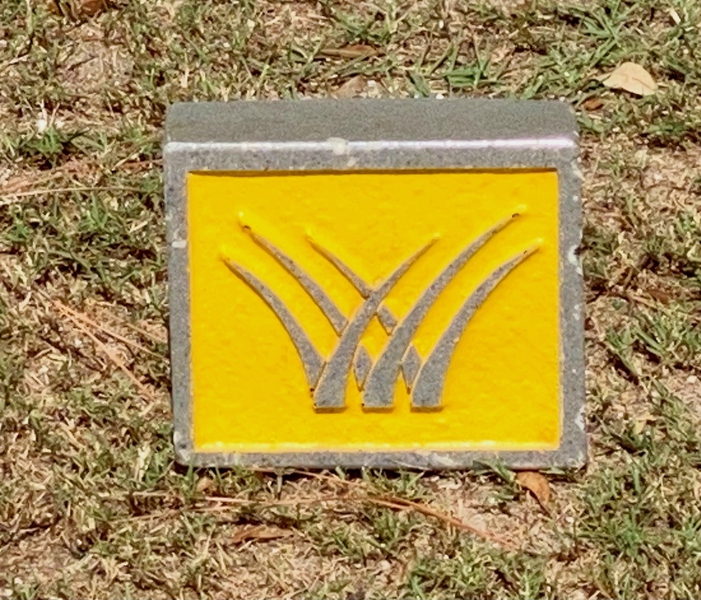Many of my fellow golfers ruin their rounds even before they step to the first tee. They play from yardages utterly inappropriate for their games. Their golf handicaps, especially when they play unfamiliar layouts, are their greatest handicaps. They rely on course rating and ignore slope ratings. Big mistake. I explain why in this edition of Home On The Course. Also, the hurricane that devastated the Ft. Myers area in Florida wound up making a second landfall on the South Carolina coast, just a few miles south of where my wife and I were staying at our condo in Pawleys Island. The day after, our golf course was a mess. Two days later, it was open for play. I explain…
The Jack Nicklaus designed Pawleys Plantation Golf Course is brutally difficult from the tips, although I wouldn’t know that personally because I have never been foolish enough to play from just over 7,000 yards. Until about five years ago, I played the 6,200-yard layout but then moved up to the 5,500-tee box (redesignated as the white, or Egret, tees in honor of the ubiquitous waterfowl that circles over the adjacent saltmarsh on the back nine).
The white tees carry a rating for men of 69.1 strokes and a slope rating of a challenging 130. (Ladies rating and slope are 74.3 and 142, respectively. I have never seen a lady play from the white tee boxes.) On my visit to our vacation home in Pawleys Plantation in late September, I decided to run a little experiment and move way up to the yellow, or “Finch,” tees that play to a total just 15 yards shy of 5,000. The rating for men from the yellow tees is modest, at 66.4, but the slope is still a robust 126. (The USGA indicates that a slope of 113 is “standard.”)
For those who may not be familiar with the distinction between rating and slope, let me briefly explain. A course rating is essentially an expectation of what a scratch (0 handicap) golfer would score on a particular layout. Slope reflects the relative difficulty of a course for players who are not scratch golfers; in my experience, it is a good comparative measure, one course to the next, for those of us whose handicaps begin in the low double digits. The lowest USGA generated slope rating is 55, and the highest is 155 (e.g. Pine Valley and the Ocean Course at Kiawah Island from the tips). Thus, those yellow tees I played twice last month should be easy for a scratch golfer; he would be expected to shoot a 66. But for someone like me, now sporting an 11 handicap, the yellow tees layout is more difficult than most.
A decade ago, when my handicap was in the high single digits, I broke 80 only occasionally from the 6,200-yard layout at Pawleys Plantation. Most of my scores were clustered in the 81 to 84 range. When I moved up to the 5,500-yard layout (the white tees), I was still hitting my tee shots a bit past 200 yards. But in the last year or two, as the muscles softened and the shoulders and hips refused to turn as much as they used to, I have found that 180 to 190 is the norm with my all-arms swing, 200 if the fairway is baked out and I catch a hard spot (or benefit from a supporting wind).
My friend Brad Chambers, who superintends the website Shooting Your Age.com and co-authored with me a book for senior golfers, has a simple reference point about which tee boxes to play for the greatest enjoyment without eliminating challenge. He suggests we should all look to the tour professionals and what clubs they generally use for approach shots to par 4 greens. On any given Sunday, and even on 500-yard par 4s, the pros generally hit mid to shortish irons. That, Brad maintains, should be the guiding principle for the choice of tee boxes for us seniors. Why should Jon Rahm and Justin Thomas hit 7-iron from 200 yards and we require, say, a 3- or 5-wood for the same distance? Stated another way, why shouldn’t we play layouts that give us a fair number of 7-iron approach shots on par 4s? And that is why I moved up to the yellow tees; because I had been hitting too many metal woods to par 4 greens, even after what I thought were decent drives.
Did playing from 5,000 yards make a difference for me? Yes it did in terms of enjoyment and what I considered a fair test for an 11-handicap senior golfer. On the other hand, it did not in terms of scoring and, generally, forgiveness for poor shots. I say “generally” because I got away with a few drives that were skied or skulled. When you play par 4s around 300 yards in length, a 150-yard drive still gives you an opportunity for a green in regulation with, say, a 5-iron or hybrid. But if your short game is awry, as mine was, and especially on a challenging Jack Nicklaus design with high-faced greenside bunkers and large, undulating greens, you will get no break on the scorecard. My two scores were 84 and 86. I have played Pawleys Plantation enough to know that had I played from one set of tees longer, I would have been lucky to break 90 either day.
(Note: After Hurricane Ian blew across the marsh and deposited boat docks and other debris onto the course, causing a rerouting of a few holes, I played a third time from the yellow tees. I had my best putting day in months and chipped in for birdie on the hardest par 4. (I also birdied the par 3 signature hole.) But a few careless second shots on par 5s resulted in three double bogies, and a few other mistakes more than wiped out those good holes.) All in all, it added up to a disappointing 84.
Here are my snap conclusions from my experiment with the 5,000-yard tees:
Postscript: I sent a review copy to my son, Tim Gavrich, who writes for GolfPass.com, and Brad Chambers, who co-authored Playing Through Your Golden Years: A Senior’s Golfing Guide with me. Tim suggested that senior golfers should play the forward tees and readjust after they meet some benchmark achievement. A 20-handicap might set a score of 90 or better as worthy of a move back one tee box. Brad reminded me about Dave Wells, now 83 years young, who has shot his age more than 200 times. He has moved up to the under-5,000 yards tees, and he and his golf pro still add his scores of 83 or fewer as shooting his age. And Brad emphatically agrees that scoring is almost entirely about the short game. “If chipping and putting are off,” he wrote me, “no one from Justin Thomas to Larry Gavrich is going to score well.” Amen to that.
Larry Gavrich
Founder & Editor
Home On The Course, LLC
A reinvigorated Hurricane Ian came ashore the last day of September on the South Carolina coast about eight miles south of my wife’s and my vacation condo in Pawleys Island. As a Category 1, it created nothing like the devastation in Ft. Myers, FL, and surrounding areas. No one lost their life on the Carolina coast and homes out on the beach remained standing, although there was considerable damage from wind and surging water. Protective sand dunes were decimated by the surge and their contents deposited onto the few roadways on the island.
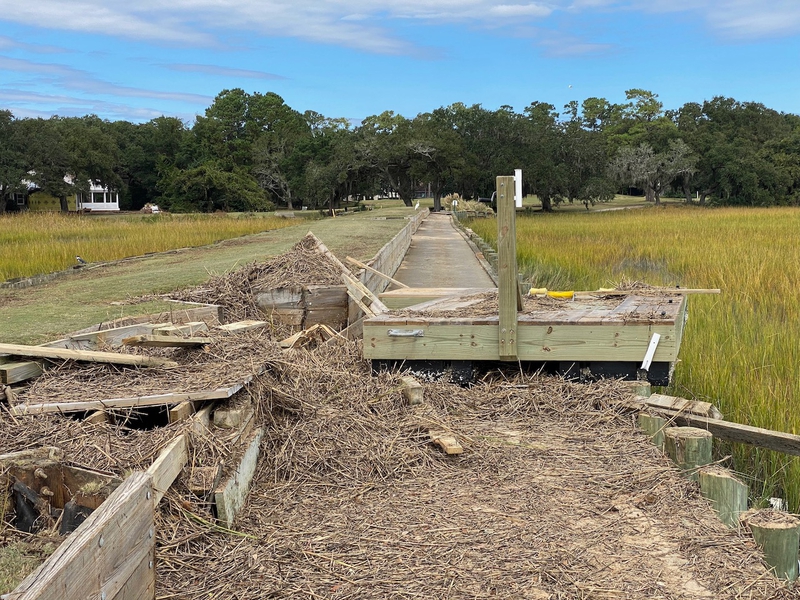
The day after the storm (Saturday October 1), we went for a walk on the back nine of the course which lies within ¾ mile of the barrier island and Atlantic Ocean where Ian came ashore with up to 100 mph gusts and an eight-foot storm surge. A boat dock, with its 20-foot boat attached, had been picked up by the surge and deposited on top of the dike that separates and holds the tee boxes for two par 3s. Pieces of docks – they looked like wooden pallets you see in warehouses carried around by forklifts – were scattered on fairways, in front of a couple of greens and across the length of the dike. We passed a couple of homes whose first-floor contents were scattered across their backyards, drying out. We emailed friends who live on the marsh to see if they would be available for dinner in the coming week. “We would love to but are clearing out our garage and may not have time,” they replied.
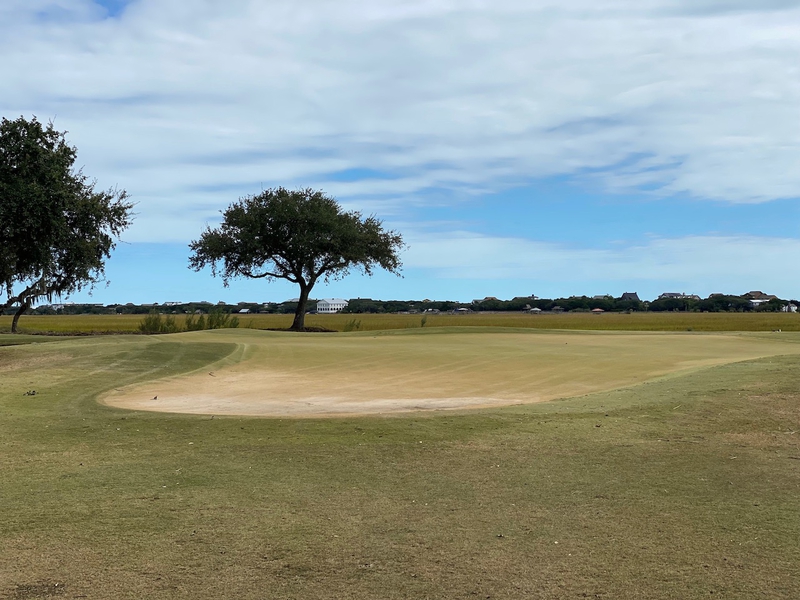
By late Saturday morning, all greens had been cleared of debris, although a few beside the marsh had turned a pale brown, showing the effects of the salt water that had passed over them. A 10-foot long, two-foot-wide piece of the green closest to the marsh, the 16th, had fallen into the bunker behind. A large tree had blown down across the first part of the fairway on the par 5 14th hole. Every fairway was strewn with small branches, their leaves still attached, as well as piles of grass clippings that had pooled together. I remarked to my wife that it looked as if it might take a week at least to make the course playable again.
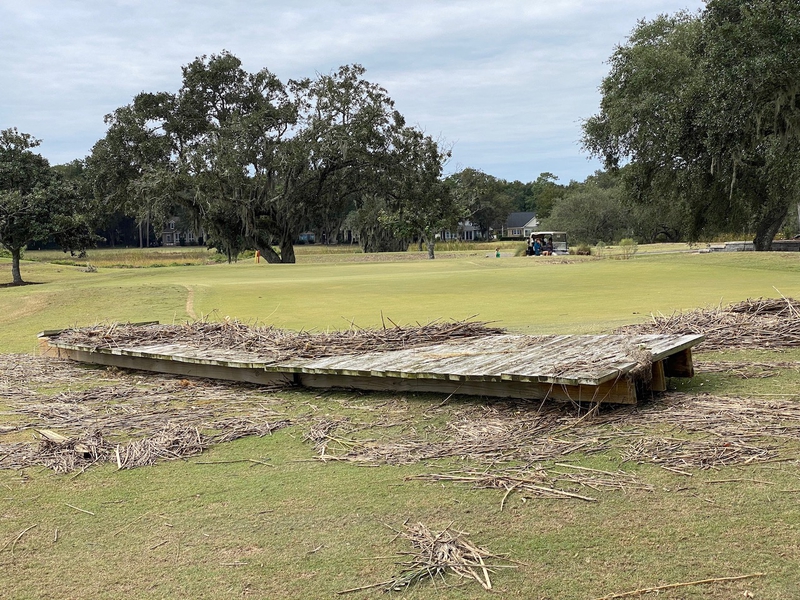
That prediction was off by about six days. The following day, the club opened the front nine which is located well west of the marsh. By Monday, all 18 were open, although club officials and course superintendent Chris Allen circumvented the impassable dike with a temporary layout that sustained the course's total yardages from each of the five tee boxes. After playing the 12th hole, the 17th became the 13th, the 18th became the 14th, the 15th and 16th remained the same, the 13th became the 17th and the 14th became the finishing hole. The rerouting did not impede pace of play; my partner and I finished in four hours behind two foursomes when we played on Monday.
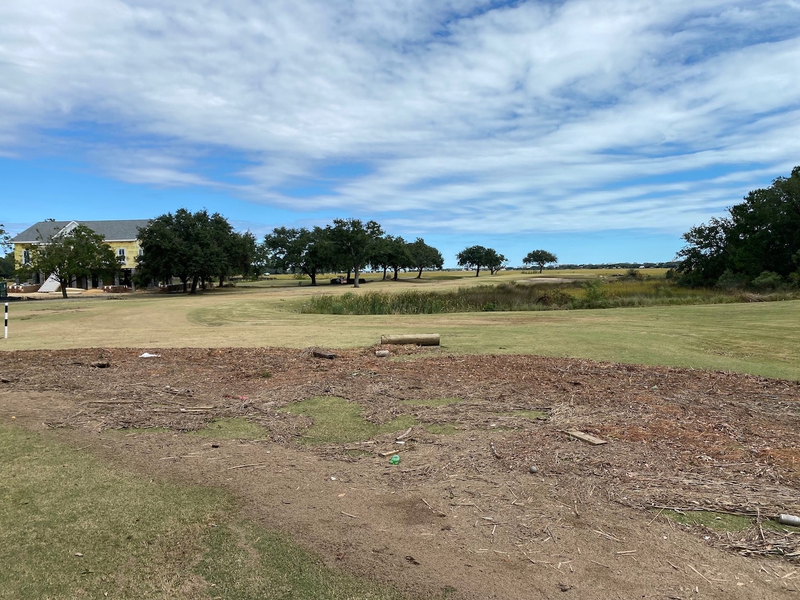
October is high season for golf in the Myrtle Beach area, and the semi-private Pawleys Plantation is one of the most popular layouts for visiting golfers. Superintendent Allen and his crew obviously had them and the club’s members in mind as they worked hard – and quickly – to restore course conditions. As a member and part-time resident, I am grateful they did.
